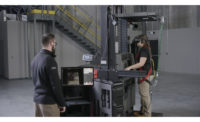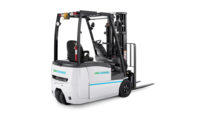With e-commerce companies rushing to add workers to meet growing demand in an already tight market, competition for warehouse workers is increasing and wages are on the rise. Despite advances in automation, warehouses are still dependent on people, and those people are becoming harder to find and retain.
One of the keys to retention is employee motivation and engagement. Workers who feel valued and find their work rewarding are less likely to look for new opportunities elsewhere. The equipment they use every day—and the feedback and training they receive—can play a significant role in how they perform and how they feel about their jobs. Here’s three strategies for reducing turnover among forklift operators.
1. Provide state-of-the-art trucks and technology.
Forklift operators develop a relationship with the trucks they spend so much time operating. A well-designed and comfortable truck creates a positive relationship and a distinct impact on driver satisfaction. Trucks that are based on human-centric design principles include features such as adjustable seats and armrests that allow operators to adapt the truck to their body type, and power steering and ergonomic controls that reduce fatigue.
Additionally, smart use of technology can eliminate repetitive tasks. For example, operators moving down an aisle to pick product must continually get on and off the truck every time they change their pick location. By giving them the ability to advance the truck remotely, they can move down the aisle without repeatedly returning to the truck, saving time and reducing fatigue.
2. Share management data.
Another opportunity is forklift fleet management. Without easily accessible performance data, high-performing operators wonder why their performance isn’t recognized and why the actions of poor performers aren’t addressed.
By equipping forklifts with wireless technology that connects to a centralized management system, warehouse managers can gather actionable data on forklift operator performance in areas such as safety and productivity. Armed with this data, organizations can reward high performers and address issues with poor performers who can erode morale. And, sharing performance data with operators, particularly positive trends, helps reinforce good behavior and can encourage operators to feel more like they are part of a team working collaboratively with management to improve productivity and safety.
This is particularly important for operators who willfully disregard safety practices. Left unaddressed, this behavior is likely to persist and even spread, as other operators begin to question the validity of practices that are being ignored without consequence. With the data and notifications from a fleet management system, managers can routinely investigate impacts to determine whether the cause of an accident was disregard for safety practices or something else.
3. Enable growth through training.
Training is essential to ensure safe and effective equipment operation, but sitting in a classroom listening to lectures and reviewing manuals often doesn’t meet the needs of today’s operators. Shifting the learning environment from the classroom to the warehouse and replacing text-heavy manuals with videos makes training accessible to operators at any time. This allows operators to integrate short training sessions into the workday to reinforce concepts in the media they are most comfortable with using to support continuous growth.
Key to this approach is learning management systems (LMS) that enable personnel to access visual content beyond the traditional classroom and help manage the delivery of appropriate content based on the operator’s skill level and performance. As operators review material and complete tasks, the individualized training helps prepare them for evaluation by—and feedback from—an instructor, creating a cycle of continuous learning and improvement.
As warehouse operators aggressively recruit workers to meet their growing demands, employee retention will remain a concern across the industry. Warehouse operators can minimize turnover and increase the value of their most important asset—people—by using data from forklift fleet management systems to proactively address problems with poor performers and reward high-performers, while leveraging new approaches to training that empower operators to learn new skills and become more proficient.



